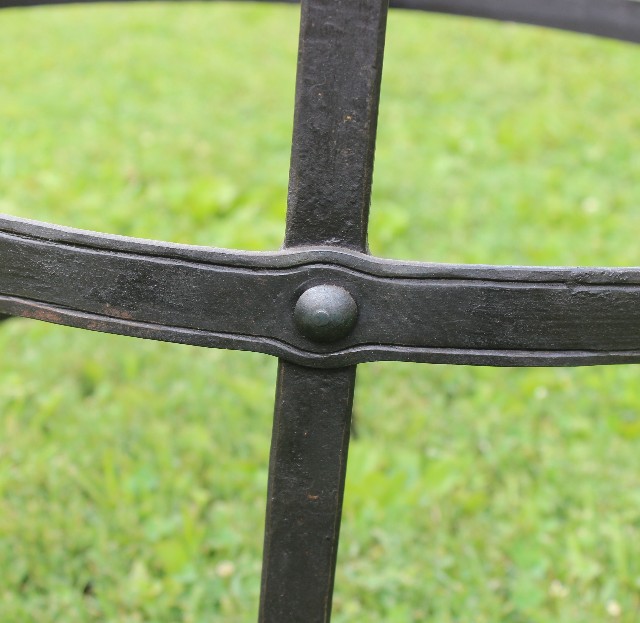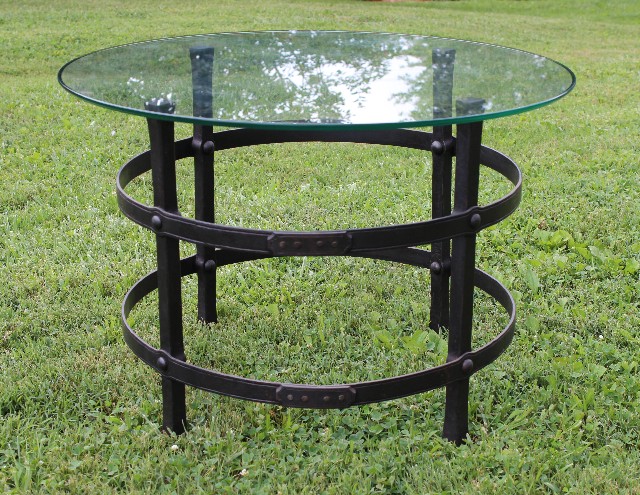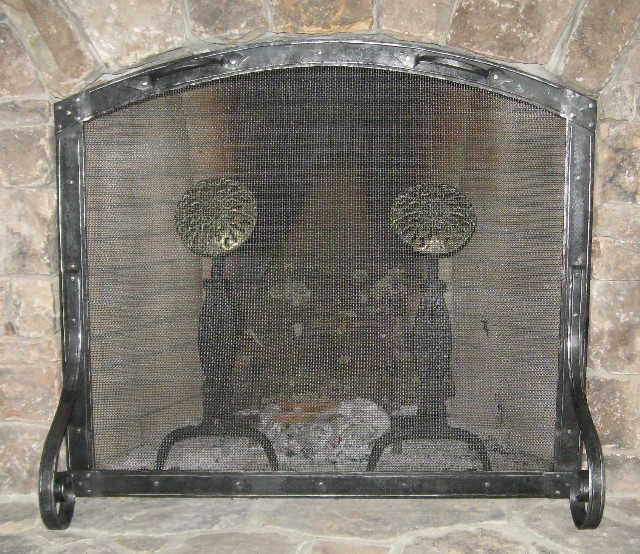
Gerald Boggs
Members-
Posts
1,198 -
Joined
-
Last visited
Content Type
Profiles
Forums
Articles
Gallery
Downloads
Events
Everything posted by Gerald Boggs
-
Axe eye splitting
Gerald Boggs replied to drakes4moose's topic in Axes, Hatchets, Hawks, Choppers, etc
From the photo, it looks as if your transitions are soft. You can tidy them up like Latticino said, " Fullering the preform at the area of the joint so you have a sharper transition at that initial weld location" It's what James Austin does with his axes. He also adds a very thing piece of high carbon between the sides, says he gets a better weld. That last is is something I've heard others say, that welding high to low is easier then low to low. What a cape chisel is, what it's used for and how to make it, is in Mark Aspery's first book. On the subject of Mark, the article was a collaboration. I did all the forging, but he did most of the rest :-) -
Show me your Bottle Openers!
Gerald Boggs replied to Arbalist's topic in Blacksmithing, General Discussion
Sorry for the delay, I don't always have the cookies on and didn't see that you had posted. 4140 is what I used. Not sure what would be best, it's what I had on hand. -
Axe eye splitting
Gerald Boggs replied to drakes4moose's topic in Axes, Hatchets, Hawks, Choppers, etc
Many times :-) -
Don Fogg is retired and his page has expired. What you saw is what you see when someone has bought the domain and wants to sell/profit from it. Don't know if the sen info is, but a lot of Don Fogg's stuff is still available at www.bladesmithsforum.com,
-
Axe eye splitting
Gerald Boggs replied to drakes4moose's topic in Axes, Hatchets, Hawks, Choppers, etc
As you've already narrowed it down to the two possible problems: Not a solid weld or being too aggressive with the drift. Lets assume the weld is fair to better, try drifting with the axe in the vice, that way the stress of drifting to taken away. And if you're not already doing this, try drifting in several short steps and lightly forge the sides, repeat. Remember, the eye should already be the size you want, all you're doing is shaping it. Hope this helps. -
While more trivia then useful information, the process is still being done on a small scale somewhere in Europe. Don't remember where, it was an article on sources for historical restorations.
-
Making a header and bucking plate is pretty easy. You can start with a drilled hole and finish the shape and size with a Bob punch. You can also use a ball bearing to get the size and shape, but you have less choice on the shape. I'll see if I can remember to take a photo of one of my sets. In the meantime, here's a photo of ½” rivets with a large flat dome. In this case, I forged the rivet head with a bolster plate and the header. Then protected and supported the head with the bucking plate, while heading the other side. I made my bucking plate to fit in the hardy. You can see examples of these at Blacksmith Depot's rivet section.
-
Seperate room for grinding
Gerald Boggs replied to HammerMonkey's topic in Building, Designing a Shop
Next I build a forge,(still deciding on whether to stay in this house, otherwise would have already) I'll be separating all my work into separate rooms: forging/general work, grinding, storage, and finishing. And an acid area under cover, but outside. -
Be interested in how the face works out after a few years of use. I have not the experience to take more then a guess, but the difference in characteristics of the two metals, leads me to think there is going to be uneven responses to the forces of using it. Most of the time, someone makes a pattern welded hammer, they weld on a mono-steel face. Please keep us informed.
-
Horizontal/Vert or Porta Bandsaw
Gerald Boggs replied to Danjmath's topic in Saws, bandsaws, hack saws, etc
If you're planning if just cutting metal into lengths and not doing cutout work, think about a dry cut saw. I've got the Makita model and did thousands of cuts before I needed to replace the blade. -
liability form
Gerald Boggs replied to Timber Ridge Forge's topic in The Business Side of Blacksmithing
When I opened a fight school/club, I had an attorney do my LLC and school liability waiver. I used the Dog Brother's Gathering warning (Crafty Dog also haven been a lawyer) as a base and asked him to make sure it covered what needed covering. He laughed as he gave me the waiver, telling me the paper had more value then the waiver written on it. He also told me that while it didn't give me any protection against lawsuits, it did have value in that it served as proof I had warned people of the dangers of letting someone punching you in the face. Sounds like he and Mr. Coe have the same advice. -
casually
-
Actually I was being sarcastic. I'm quite in a state of disbelieve that you would so causally dismiss the value of studying the works of old. Your country is so rich in architectural history. Aside from the bombings of London and other major cities during WW11, you haven't had a war on your soil since before my country became a country. Few other countries can claim such richness, we in America have very little of that. Here, we think of a building built in 1899 as OLD. I was only in England and Wales for 3 ½ months, working in my friend's (First smith I worked for) dad's shop. On the weekends, I would explore the countryside looking for ironwork to study and photo. My eye for detail and my understanding of both the artistic and functional sides of ironwork grew so much from that experience. Granted, I was in the land of the Davies brothers and got to see several examples of their work. Sorry you're so bound by council rules. When I was in Shropshire, I build and installed several gates and there was never any issues from the council. I was under the impression that Britain was pretty much like the US, aside from codes for swimming pool and powered gates, there isn't any. When Stokes of England built the millennium gate (2000) in Oswestry to commemorate the continuous tradition of fine handcrafted ironwork, nobody from the counsel come by and told them how to build the gate.
-
Really?
-
That was not my experience when I was over there. (Winter of 2003-4) I studied and took photos of what felt like a endless number of gates. It got to the point I wasn't taking photos unless there was something different.
-
The aesthetics of gate design are very personal. What one might like, another will look upon with distaste. You live in England, just wander the countryside and you'll see hundreds of gates. From church lychgates to the gates of manor houses. Look at them, study them, take photos, and make sketches of them and in time, you'll develop your own sense of aesthetics. But no matter what you design, the mechanics will effect what you can do, gravity is always there.
-
Interesting how the internet is working. I posted about wire mesh for fireplace screens and I just received spam from a Chinese company wanting to sell me wire mesh.
-
I don't use H13, but I know smiths that do. Some have used it for years and like it. Others have made trips to the hospital ER. Make your own choices and reap the benefits.
-
I agree, it is as easy to weld as other tool steels.
-
My recommendation is to stop using O-1. O-1 is good steel, both for knifes and chisels, but requires precise temperatures in all steps during forging and heat treatment. Unless you have the equipment to do that, you will not get the benefits of using O-1. Since most of the time, it's more expensive W-1, it's better to use W-1 or one of the other simple carbon steels. I've also found 5160 to be a generally good steel for knife blades and forgiving in the forging process. Both W-1 and 5160 forge weld to mild.
-
I'm not sure to what the frame shape/size you're using, I generally use 2” by 3/16 flat bar. To attach the wire, I sandwich it between the frame and 1” by 3/16 flat bar using screws and switch over to rivets to finish. To get and keep the screen tight, I first take it to my local machine shop and have them counter-roll it though rolling dies. That has two effects: makes it flat and hardens up the wire. With the gauge I use, that's all I normally need to do. However, if for some reason I have a bit of sag, I rivet one side, position the frame so the other side is right at the end of the table and clamp the riveted side down. I then clamp a length of flat bar to the excess screen extending out from the not riveted side. If I lever that down against the side of the table, it takes all the slack out. Hopefully, that was clear enough to be of help.
-
Forge welding with anthracite/rice coal
Gerald Boggs replied to JHCC's topic in Blacksmithing, General Discussion
I've done a bit of welding with Rice and posted photos here of the results. (Like many, the photos have vanished) Treat it like fine coke and you'll be fine. Never turn the air down all the way as it takes a long time to come back up. And be careful about too much air, you can blow the fire apart. Add new fuel directly on top, there's no coking going on and therefor no need to put it to the side to "coke up" A deep fire works better and I find fire brick sides and back help in keeping a deep fire. If you've every visited James Austin's web site, the method he uses is what I talking about. -
No idea, a quick search didn't show that change in the law. I do know that it comes up ever couple of years. I had read that states are requiring on-line sellers like Amazon to collect if they have any warehouses/distribution centers in the state. As for the shows, really not that hard, one just needs to get an out-of-state tax number and file as needed. Some shows do the leg work for you, state will send you a onetime form to file.
- 13 replies
-
Some places are a quagmire of bureaucracy, others are quite easy, open and friendly, a quick visit to your local business license office will tell. Here in Nelson county, Virginia, my thirty minute drive took longer then getting everything I needed done: Approval to have a blacksmith studio at my location and a $35 per year business license. Plus a telephone call to the sales tax folks (on-line now days)
- 13 replies


